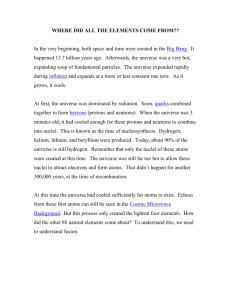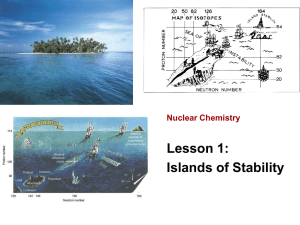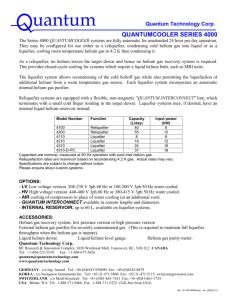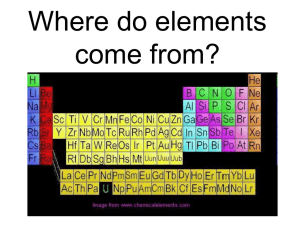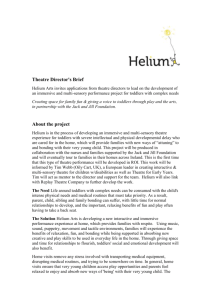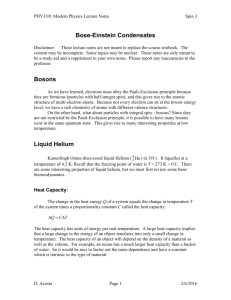Helium
advertisement
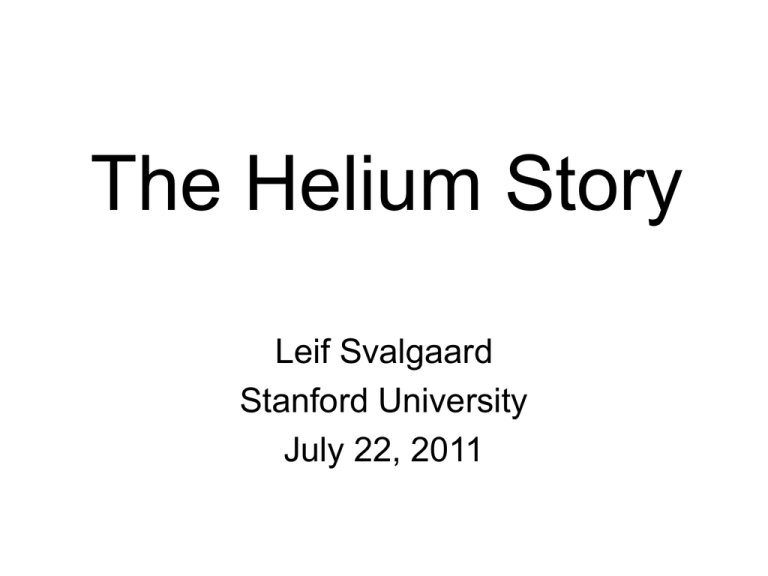
The Helium Story Leif Svalgaard Stanford University July 22, 2011 Spectrum of Helium 587.49 Named after ἥλιος (helios, the sun) because He was first discovered in the solar spectrum [yellow line D3] Helium is misnamed, as ‘-ium’ is normally used with metals. The gas should perhaps better have been named ‘helion’, cf. Argon, Neon, Krypton, Radon Discovery of Helium Norman Lockyer xx1836-1920 xxxx1868 Janssen and Lockyer observed the D3 line in the chromosphere and Lockyer proposed to some ridicule that the line was due to a new element not yet found on Earth Jules Janssen x1824-1907 xxx1868 Luigi Palmieri 1807-1896 Lava D3 1882 Also founded the journal Nature William Ramsay 1852-1916 Clevite 1895 Per Theodor Cleve Adolf E. Nordenskiöld 1840-1905 1832-1901. Discovered Clevite 1895 Clevite 1878 The Noble Gases It is hard [and dangerous] to collect enough Radon for a discharge tube He’s place in the Periodic Table Although ‘noble’ [because of closed electron shells] most noble gases can [with some difficulty] form compounds with Flourine and Oxygen. I don’t know of any He-compounds, except hydrohelium HeHn+, that are positively charged ions formed by the reaction of protons with a helium atom in the gas phase, first observed in 1925 and probably present in interstellar clouds and some white dwarfs. It is the strongest known acid [with n = 1]. Where does the Helium come from? • Helium is formed in stars, e.g. the protonproton chains • But largely stays in the stars as they die • Because supernovae forming heavier elements actually burns the Helium • So, 98% of He must be ‘primordial’, i.e. formed before the stars Formation of Helium in the Early (< 3 minutes) Big-Bang Universe p p Cannot [and does not] exist, so to build Helium we need to add neutrons as above, so the number of neutrons is the controlling factor in the above reactions Estimating the number of neutrons, I The average energy of a particle at temperature T is Eavg = 3 kT / 2, where k is Boltzmann’s constant. If a neutron and proton with that energy collide, the total energy in the restframe of the collision is Ecol = 2 Eavg = 3 kT. The binding energy of Deuterium is 2.225 MeV, so the temperature TD at which Deuterium begin to form from collisions of protons and neutrons can be estimated by equating its binding energy to Ecol: kTD = 2.225 Mev/3, so, since k = 8.617 * 10-11 Mev/K, TD = 8.6 * 109 degrees K. The probability of finding a particle with energy E = mc2 at a temperature T is determined by the Boltzmann factor exp(-E / kT). Estimating the number of neutrons, II So the number of neutrons, Nn, available to form Deuterium at TD would be proportional to exp(-mnc2/kTD), and the number of protons, Np, to exp(-mpc2/kTD), so the neutron fraction would be Nn/Np = exp(-(mnc2-mpc2)/kTD) = 0.175, using the mass difference mnc2-mpc2 = 1.293 MeV. Thus Np = Nn / 0.175 = 5.7Nn and Nn+Np = Nn+5.7Nn = 6.7Nn, so that Nn/(Nn+Np)= 1/6.7 = 0.15. Thus 15% of the number of nucleons formed in the Big Bang will be neutrons. These will combine with an equal number of protons to form Deuterium which eventually combines in pairs to form 4He, so that the 4He abundance will be roughly 30% by mass. Taking into account that neutrons decay with a half life of only 886 seconds lowers that estimate to about 24% which is, in fact, what is observed. John W. Draper, first president of the American Chemical Society declared in 1876 in his inspiring presidential address: “And now, while we have accomplished only a most imperfect examination of objects that we find on the earth, see how, on a sudden, through the vista that has been opened by the spectroscope, what a prospects lies beyond us in the heavens! I often look at the bright yellow ray emitted from the chromosphere of the sun, by that unknown element, Helium, as the astronomers have ventured to call it. It seems trembling with excitement to tell its story, and how many unseen companions it has. And if this be the case with the sun, what shall we say of the magnificent hosts of the stars. […] Is not each a chemical laboratory in itself?” Indeed, the stars and the whole Universe are chemical laboratories and we can now tell that story.


